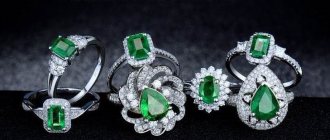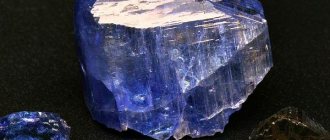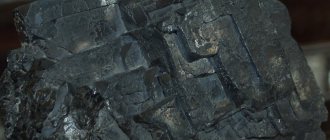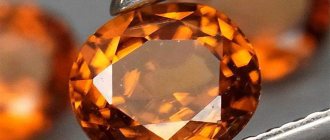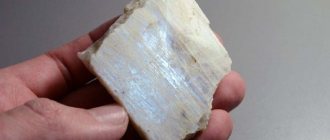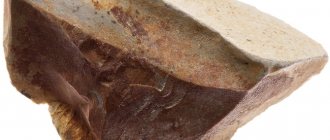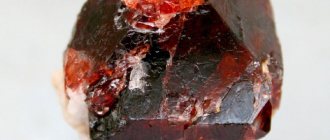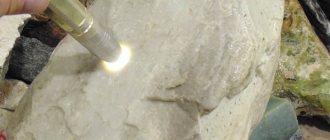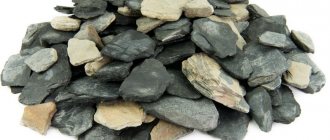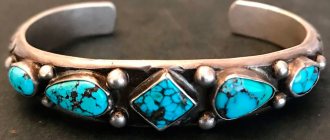A fossilized ammonite is the remains of an ancient mollusk from the order Cephalopods. They lived in the Paleozoic era and died 100 million years ago. Mollusks were one of the earliest forms of earthly life. They lived in ancient sea waters. Ammonites died during the Cretaceous-Paleogene mass extinction, and their shells were forever fossilized. Currently, about 3 thousand varieties of shells are known.
Who came up with the name
In the 1st century AD, the ancient Roman writer Pliny the Elder named the shells "ammonis cornua" after the god Amun of Thebes from ancient Egyptian mythology. He patronized the Universe and air.
Amon was depicted as a human ram with curled horns. They look like a spiral of shells. That's why the ammonite got its name.
In 1749, biologist Georges Louis Leclerc Buffon spoke about ammonites in the pages of his encyclopedia.
40 years later, French zoologist Jean Brugier proposed the Latin name “ammonitos”.
The English referred to the shell as a “twisted stone” until the 19th century. And the Germans are a “golden snail”.
The Irish called the ammonite a “petrified snake” because of its layered surface. It looks like snake skin.
Story
The spiral shape was revered in primitive and later cultures. It was considered mystical and divine, as it meant the eternal cycle of time: everything is repeated in this world, but with each turn it moves to a new level.
History of the name of the stone:
- The ancient Egyptians named these fossils after the Sun God and the Aries constellation Amon. His images with intricately curled ram horns are known.
- The Romans who conquered Egypt called the fossilized mollusk shells the horns of Amon.
- At the end of the 17th century, the French scientist Jacques Bruguier added the name of these fossils to the European register of paleofinds - scientists began to call them ammonites.
In Germany, ammonites were called golden snails, and in Ireland, petrified snakes.
Place of Birth
Mollusks were sea inhabitants. But over millions of years, geological changes have occurred on the earth. Therefore, today ammonites are found on almost all continents in sedimentary rocks. Archaeologists found only one example in Burmese amber.
Shells are mined in Canada, the USA, Madagascar, Morocco, Western Europe, Japan, and Australia. In Russia, fossilized shells are found in the Krasnodar region, 120 km from Krasnodar. Samples weighing 1.3 kg and more than a meter in diameter lie here.
Most often, geologists extract samples with a diameter of up to 10 cm. There are shells measuring 1-1.5 m in size. But there are also tiny ammonites – 1-2 cm.
In Germany (according to other information in Brazil), a shell with a diameter of 2.5 m was found. This sample is a record holder among ammonites.
In Morocco, Madagascar and Canada, shells with gems in the cavity are mined.
Shell properties
Externally, the ammonite stone looks like a small snail. It is highly valued by scientists and collectors.
There is a belief: if a person finds an ammonite, he will be haunted by happiness and good luck all his life.
The clams had a tough shell with a high content of calcium carbonate or phosphate.
A distinctive feature of mollusks is that they petrify well. Their jelly-like body decomposed, and the shell absorbed minerals. Therefore, ammonites survived after many millions of years.
The hardness of the shell is 5.5 on the Mohs scale.
Structure and types
Ammonite is a shell of several chambers with partitions and a siphon tube. Thanks to this structure, the mollusk had the ability to choose its diving depth.
Most fossils have coils in the same plane. They resemble a shell or a snake ball.
Fossilized mollusks with asymmetrical shells are also mined. But such ammonites appeared only in the Cretaceous period. Therefore, today such shells are found less often, and their value is higher.
Geologists call symmetrical ammonites monomorphic, and asymmetrical ammonites heteromorphic.
Paleontologist Larisa Doguzhaeva claims that shells with a heteromorphic inner shell existed.
There are three types of shells:
- Evolute: turns slightly touching;
- Semi-evolute: the turns overlap each other;
- Involute: a new round completely overlaps the previous one.
Smooth and sculptured shells with various types of branching are known.
There is erroneous information that ammonite is equated with semi-precious stones. This is not true. This category includes ammolite - particles of the mother-of-pearl layer of ammonites.
Historical reference
Ammonite shells
Ammonites (the second name is ammonoids) are prehistoric mollusks that inhabited the earth from the Devonian to the Cretaceous periods, that is, 400-65 million years ago. They appeared before dinosaurs and disappeared along with them during the Cretaceous-Paleogene extinction.
Ammonites resembled modern snails in appearance. They had a spiral-shaped shell, consisting of a large number of chambers - filled with gas, liquid and residential ones, where the body of the mollusk was placed. This structure of the shell made it possible for its inhabitant, who lived in the ocean, to regulate the depth of his dive.
Scientists are only making assumptions about the appearance of the mollusks themselves, since their remains have not been preserved. According to one version, ammonites had at least 10 tentacles on their “muzzle” and huge eyes, allowing them to see well in the water column.
Shape and color
The color depends on the presence of minerals in the shell chamber. The fossil is filled with pyrites, chalcedony, jasper, simbircites and other calcites. Therefore, the shells are predominantly white, yellow, and dark honey in color.
Black fossils are rare.
If there is pyrite in the shell, a golden layer covers its surface. Specimens with mother-of-pearl inside and outside are often mined.
Ammonites with iridescent surfaces are highly prized. This rare variety is found in North America.
After jewelry processing, the shells shimmer in red, green, blue, and yellow tones.
Jewelry with mineral
High-quality jewelers create truly works of art from fossils. The decorations are unique, each in their own way; this is facilitated by the magnificent colors and bizarre shapes of the shells.
Also read: Antimonite - a stone of spiritual self-improvement
Small sized clams are used for jewelry. The more colorful and pearlescent the surface of an ammonite, the higher its value. Approximate prices for fossils are provided:
- price for a polished ammonite from Madagascar, size 3x3.5 cm – $10;
- ammonite measuring 5x4 cm, mined in Saratov, costs $16;
- a polished fossil from Madagascar, measuring 5x6 cm, costs $25;
- a unique example of a polished ammonite cut, measuring 17x14 cm, brought from Madagascar, costs $280;
- polished cut from Karachay-Cherkessia, size 23x19 cm, costs $455;
- Ammonite from Morocco costs $20
Clam shell can be suitable for pendants, necklaces and other precious items. What color of metal the fossil goes with depends on the shade. To get an original piece of jewelry, you can buy a shell fragment and order an exclusive piece.
Healing properties
The Legend of Saint Hilda
There is a well-known legend about the healing properties of ammonite. One day England was overrun by poisonous snakes. They attacked citizens on the streets and crawled into their houses through the water supply system. Due to snake bites, mass deaths of adults and children began.
The country was saved by the nun Hilda. She prayed to heaven for a long time for salvation from the misfortune. The prayers worked.
All the snakes curled up and fell into the sea from the cliff. Soon the reptiles completely disappeared from the streets and houses.
After this event, local residents found frozen shells on the shore. They began to be used in medicine, and the nun was considered a saint.
Amulets engraved with her name became widespread. To this day, ammonite fossils are called St. Hilda's stones.
What cures
Official medicine does not confirm the fact of therapeutic effects on the body. In no case should you replace drug therapy under the supervision of a physician with procedures with ammonite!
But traditional healers believe in their healing power. They advise wearing shell earrings or a pendant to treat skin rashes and hair loss.
According to lithotherapists, the fossil helps cure mumps, scarlet fever, and chickenpox in children. Supposedly, you need to put a piece of shell in your pajama or overalls pocket.
The shell saves you from insomnia. People put it under their pillow or on the nightstand near their bed at night. Jewelry with fossils can help lift your mood and cope with depression.
The Egyptians used ammonite powder to treat wounds. And the Chinese did massage with a sink. They believed that such a procedure fills a person with strength and positive energy.
Magic properties
Rituals
Since ancient times, shells have been attributed magical properties. Sorcerers used them in rituals and believed in the ability to summon water spirits.
In India, shamans performed rituals with shells to attract showers. They believed that the fossil would help them find hidden sources of water and underground rivers.
The Indians called the shells "buffalo stones." They were taken with them on hunts in the hope that such a talisman would make the owner more accurate.
It was believed that the spiral of the shell symbolizes eternity and will give its owner many years of a happy life.
Modern sorcerers also use fossilized shells in magical rituals. This original amulet helps to establish a connection with the other world and summon good spirits.
According to magicians, the shell is more suitable for “white” magic. If you use it in dark rituals, all evil will come back doubled.
Who is suitable according to the horoscope?
According to astrologers, the shell will bring good luck to Capricorns, Aries, Gemini, Aquarius, Libra, Pisces, Scorpio, and Cancer. The fossil especially favors people whose occupation is associated with water - sailors, fishermen and others.
For representatives of other zodiac signs, fossil is neutral. It won’t bring problems to life, but you shouldn’t count on any special luck either.
Amulets
Sorcerers believe that ammonite amulets have powerful powers. The shape of the shell follows the spiral structure of galaxies. Therefore, ammonite is inextricably linked with space. He receives a powerful charge of energy from it and transfers it to the owner.
The magical properties of the fossil help you look at things rationally and not lose composure in any situation.
It is dangerous to keep a shell in your pocket due to its high fragility. Therefore, wear jewelry made from it or place it in a visible place at home - a table, a fireplace, a hanging shelf.
Products made from ammonite have long been considered a symbol of wealth and family well-being. They were passed down from generation to generation and carefully preserved.
Magicians advise using small, brightly colored fossils as a talisman. They are called "seven-colored stones of prosperity." They contribute to material well-being and create an atmosphere of peace and love in the family. Ammonite is given to newlyweds as a wedding gift.
But the shell cannot stand being near stones. Magicians do not recommend wearing ammonite jewelry with jewelry.
Who is ammonite suited to according to the zodiac?
Ring with ammonite
To one degree or another, ammonite suits all zodiac signs. But first of all, astrologers recommend wearing ammonite to water and air signs.
- Aries strength to solve any problems. This zodiac sign, under the influence of the talisman, becomes successful and rich. Any difficult task is given to him easily and Aries achieves high results in solving it.
- Taurus is hardworking and can achieve career heights and financial well-being on his own, but ammonite will give energy and strengthen all the business qualities of Taurus.
- Geminis are full of plans and ideas, but their mood often changes and things remain unfinished. The talisman gives strength, patience, and determination, which allows you to bring your plans to the end.
- For Cancer , this is the best talisman with which you can make any wishes and start any business. Family occupies a special place for Cancer. Ammonite helps strengthen ties between household members.
- Leos love to be the center of attention; self-realization is important to them. Ammonite will help with this. He and Leo establish such a close connection that it is enough just to think and the wish has already come true.
- Virgo becomes harmonious and successful. The talisman adds energy and positivity, enhancing the positive qualities of the sign.
- Libra with ammonite will even out your mood, learn to deeply understand the world, and strengthen your intuition. The talisman will also improve the health of this sign.
- The character of Scorpio is tough and strong, ammonite will add softness, warmth, teach you to better understand others, and show the world in a different, more positive light.
- Sagittarians are ardent, passionate and impetuous. They do not know how to wait for the right moment and act on emotions. The talisman will add rationality and patience.
- For Capricorns, ammonite will be a means to unite the family and improve relationships with loved ones.
- Aquarius to indulge in idleness and will direct energy to creation, achieving goals and implementing plans that have been postponed until later. It will also strengthen ties with family and prevent outbursts of hysteria from ruining family relationships.
- Ammonite and Pisces are a great match for each other. Cold and apathetic fish, under the influence of the talisman, seem to wake up, become active, perky and look at the world optimistically.
When choosing a talisman, you need to rely on intuition. If the horoscope speaks of absolute compatibility, but the soul is not in love with jewelry, then it is better not to use it, because individual character traits and energy make adjustments to the ideal description of the stone made by astrologers.
There are many mysteries and secrets in history. Man can only guess what the world was like many millions of years ago. The earth has preserved some hints of this, preserving the remains of ancient lizards, mollusks, insects and plants. Ammonites are one such hint; they are part of the history of our planet.
Sources and literature
- Drushchits V.V. Lower Cretaceous ammonites of the Crimea and the North Caucasus. Lithoceratids, tetragonitids and phylloceratids.
- Rogov M., Nelikhov A. Giant horns of Amun // Paleomir. - 2008. - No. 1 (4). - pp. 32-47
- Ammonites / Chesunov A.V. // A - Questioning. - M.: Great Russian Encyclopedia, 2005. - P. 620. - (Big Russian Encyclopedia: [in 35 volumes] / chief editor Yu. S. Osipov; 2004-2017, vol. 1)
- Ruppert E. E., Fox R. S., Barnes R. D. Lower coelomic animals // Invertebrate Zoology. Functional and evolutionary aspects = Invertebrate Zoology: A Functional Evolutionary Approach / trans. from English T. A. Ganf, N. V. Lenzman, E. V. Sabaneeva; edited by A. A. Dobrovolsky and A. I. Granovich. — 7th edition. - M.: Academy, 2008. - T. 2. - 448 p. — 3000 copies.
- Fundamentals of paleontology: Handbook for paleontologists and geologists of the USSR: in 15 volumes / chapter. ed. Yu. A. Orlov. - M.: Publishing House of the USSR Academy of Sciences, 1962. - T. 5: Mollusks - Cephalopods. I / ed. V. E. Ruzhentseva. - P. 243. - 442 p.
- Count de Buffon. General and private natural history. — 3rd ed. with additions and corrections. - St. Petersburg: Imperial Academy of Sciences, 1801. - 380 p.
- Ammonites on the Wikipedia page ru.wikipedia.org.
5 / 5 ( 14 votes)
Proper care
Products made from ammonite are fragile and require careful handling. The shell will at least crack if it falls on a hard surface.
Store ammonite products on a stand out of the reach of children. For jewelry, select a separate case with a velvet lining. Do not store the shell in a soft bag. This material will not protect against impacts.
Once every six months, wash the fossil in soapy water and wipe with a microfiber cloth.
Aggressive chemicals will damage the surface of the product. Long-term exposure to sunlight and high temperatures is harmful to shells.
Prices for ammonite products
Ammonite jewelry
Jewelry or collection value is determined by the degree of preservation of the mother-of-pearl layer or the aesthetic characteristics of the minerals that fill the shell or impregnate the walls.
You can buy the mineral at the following average prices:
- ammonite 30x30 mm – $20;
- ammonite with ammolite, polished (Madagascar, 40–45 mm) – $15-30;
- ball (74 mm) – $100;
- egg (71x41 mm) – $90;
- pendant (25–45 mm) – $15-20.
The price is affected by the composition. Thus, the cost of a pyritized agglomerate or with simbircite inside reaches thousands of dollars. The most beautiful and expensive variety of ammonites is ammolite. He is like a petrified bright rainbow.
